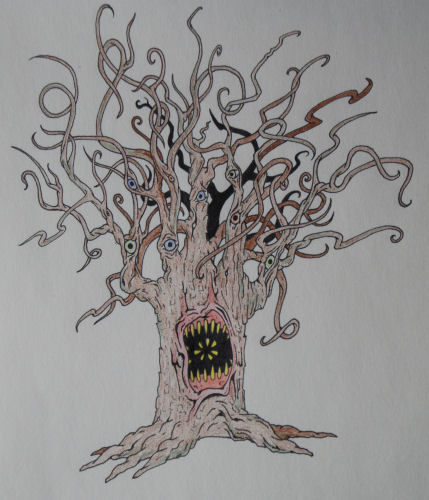Just in time for spring hikes and picnics in the park, let’s explore why you should never trust that seemingly friendly elm tree along the trail. Sure, it gives you and your family shade on those especially sunny days. But the only reason that chlorophyll trickster hasn’t eaten you yet is because your cotton-poly blend shirt might give it indigestion. Behold the Ya-Te-Veo: The Man-Eating Tree.
One of the most famous accounts of man-eating trees occurred in 1874. Or 1881. These folkloric incidents prove nearly impossible to pin down, making cryptozoology a fact-checker’s nightmare in more ways than one. Anyhow, at some point between 1850 and 1900, German explorer Carl Liche traveled to Madagascar and met up with the Mdoko (or Mkodo) Tribe. As a kind of rag tag A-Team for the Victorian generation, they surveyed a world of serene rainforests, potential malaria, and most importantly, aye ayes. Things were probably looking pretty good for everyone involved. The tribe presumably got some serious bullion just for walking through their own backyard with the unequipped foreigner. And for his part, Liche was garnering all kinds of great stories to tell back home over the wiener schnitzel (hey, with a last name like Kiste, I’m mega-German, so let me have my wiener schnitzel jokes. It’s the closest I’ve got to the Motherland).

However, one day, all the fun came to an abrupt end. Liche and the Mdoko stumbled upon a clearing, the tried and true way to discover things, both good and bad in nature. There, in all its dodgy splendor, was a towering tree that Liche described as looking like a giant pineapple with long, wiry tendrils and indents in the bark that appeared to be eyes. That begs the question of how exactly the thing resembled anything remotely similar to a pineapple, but maybe Liche wanted to sound exotic when describing the scene to his skeptic European friends. The Mdoko men used their javelins and poked one of their female traveling companions until she approached the tree and drank the squalid liquid dripping from it. At this point, the Ya-Te-Veo (or Yateveo) awoke, squeezed the woman with its hideous branch arms, and proceeded to devour her whole.
Now without delving too far into the precarious specifics, this story spotlights some pretty major issues. First off, what exactly did Liche do while they threw the helpless woman into the tree? Sit there quietly and take notes? “I’ve got to get every detail of this right. Otherwise, they’ll never believe me at home!” As for the Mdoko men, they’re apparently so lacking in the basics of chivalry that they plan ahead and bring a woman along on excursions just in case they need an impromptu sacrifice. And if they didn’t already sound like total sadists, they force her to drink the probably poisonous juices from random forestry orifices (and for what it’s worth, even the Victorians probably picked up on that sexual symbolism). What happened to those worldwide sexist norms of the time regarding who went on jungle journeys and who stayed back with the children? Chances are no female would be permitted to go, even if the Mdoko did think the forests held a man-eating tree somewhere in its depths. Something’s not adding up here…

Turns out none of it should add up, seeing that the whole thing was phony. No Ya-Te-Veo, no Mdoko tribe, not even an explorer named Carl Liche (which also means no stories told over the proverbial wiener schnitzel). Major fail. The whole yarn was invented to sell newspapers. Yes, that’s right. It’s not just World Weekly News, the National Inquirer, or TMZ that occasionally embellishes the truth. Europeans basically schooled America in the practice. And what better way to tell tales of far-off lands than make the tribal leaders sound like barbarians, eager to feed their wives off to the nearest hungry palm tree?
Still, that doesn’t mean our legend simply ends there with a big declaration of malarkey. Madagascar isn’t the only place that lays claim to the Ya-Te-Veo. Folklore concerning man-eating plants are basically tales as old as time. For many people, nature inspires fear, and especially among old timey colonials who had to rely on land they rarely knew or understood, every sound could spell looming danger and sometimes death. And just when you thought wolves, big cats, and bears were the primary contenders for scariest woodland creature, that laid-back oak takes a chunk out of your buddy’s shoulder. Maybe he just scraped up against a limb when fleeing said big cat, but in any scenario where Mother Nature can play the role of villain, you better believe there are those out there who will seize the opportunity.
Similar accounts, some minus the obligatory human sacrifice, have proliferated over the years. Other places in Africa, including Egypt, as well as Central and South America are called major hot spots for the Ya-Te-Veo. In fact, a whole field of study exists that focuses on unusual and heretofore unrecognized plants: cryptobotany. Paging, Dr. Ellie Sattler. And even if you think a giant ravenous tree hungry for human flesh seems ridiculous, remember that if a Venus flytrap grew large enough, it would be happy to invite you and your whole family over for dinner.

So next time you think your neighborhood pine looks a little too affable, pull your dog’s leash a bit tighter and pick up the pace. No reason to spoil a perfectly fine spring afternoon.




